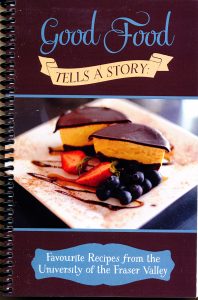University of the Fraser Valley Library (2015). Good food tells a story, favourite recipes from the University of the Fraser Valley. Abbotsford, BC: Author.
This is a recipe book assembled by faculty and staff at the University of the Fraser Valley (UFV) as a fundraiser for the Newman Western Canadian Cookbook Collection, part of their Special Collections Library. It’s a community cookbook that reflects the diverse influences and food practices of this community. It has recipe sections headed: Breakfast, Breads, Soups & Salads, Mains, Vegetables, Sweets, and Extras. The book is coil bound, 109 pages long and contains 79 recipes.
Most recipes include a brief story by the contributor about the origin of the recipe, who made it, when and how it was made and tips for serving. The contributors are men and women. The stories indicate that recipe preparation is often a social event; that recipes were often learned by working with a parent or grandparent, and that food preparation today is often done cooperatively for and with other family members (pizza, overnight buns for example). Recipes were gleaned from friends, chefs, parents, and a home economics class. For many, food evokes childhood memories and recipes are a way to retain and build culture. Influences are from Scotland, England, Peru, India, Newfoundland and Labrador, and other Canadian provinces. Recipes included are traditional and novel and include oatcakes (from Scotland), naan (from India), panackelty (from England), fish and brewis (from Newfoundland), haggis, baked beans and dogberry wine (dogberry is the name for the berries of a native mountain ash in Newfoundland). The book is for experienced cooks because it does not include any guidance on measurements or abbreviations (although no abbreviations are used). An index is included. Recipes are written using only Imperial measures, not metric.
If there is a collective story told by the recipes it is that UFV faculty and staff love sweets (30 pages, 24 recipes) making it the largest section in the book. Vegetable recipes are fewer — 5 in that section with three of the five recipes for potatoes. And what does it say that three of the eight salad recipes are for jellied salads?
Like other community cookbooks, we can expect that the recipes offered in this book have been frequently tested in the homes of the contributors. Many are adapted from other sources. It’s a book that you will want to keep and try many of the recipes included. It is also a good example for other community groups that want to develop a cookbook. Community cookbooks often include poetry or bits of daily life philosophy but this one does not. Some photos are included and the stories that accompany the recipes make it informative and enjoyable. The coil bound format is easy to use. The length makes it very affordable ($10).
Information on purchasing a copy is at: http://libguides.ufv.ca/NewmanCollection

